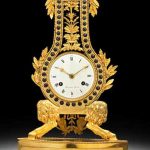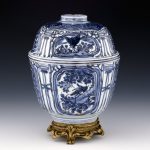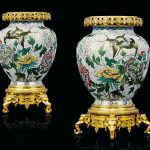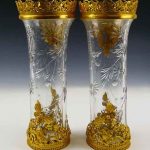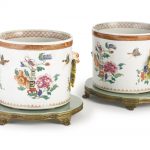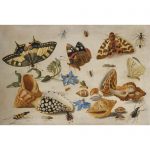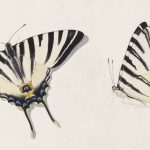Ormolu is an English term, used since the 18th century for the gilding technique of applying finely ground, high-carat gold–mercury amalgam to an object of bronze, and for objects finished in this way.
The mercury is driven off in a kiln leaving behind a gold coating. The French refer to this technique as “bronze doré”. In English, it is known as “gilt bronze”.
The manufacture of true ormolu employs a process known as mercury-gilding or fire-gilding, in which a solution of mercuric nitrate is applied to a piece of copper, brass, or bronze; followed by the application of an amalgam of gold and mercury. The item is then exposed to extreme heat until the mercury vaporizes and the gold remains, adhering to the metal object.
This process has generally been supplanted by the electroplating of gold over a nickel substrate, which is more economical and less dangerous. Reference: Wikipedia
A late 18th century French ormolu mantle clock Signed for Breguet, Paris Modelled as a stylised lyre surmounted by a flaming urn over the shaped frame with applied foliate mounts and set with blue enamel plaques, each with a gilt star, raised on two goats leg feet on an elliptical plinth base with beaded border and toupie feet, the signed Roman dial with Arabic quarters and gilt hands, the two train drum movement with silk suspension to a pendulum modelled as opposed butterflies, and outside countwheel strike on a bell. 43.5cm (17in)
Sold for £ 2,750 inc. premium at Bonhams in 2016
Porcelain covered bowl with ‘kraak’-type underglaze blue decoration and ‘ormolu’ mount. This moulded bowl has high slightly flared sides and a tapering foot, while its domed cover has a flared rim and a ring knob. Inside the bowl in the centre a crow is perched on a rock, surrounded by four radiating panels with opposite pairs of hollyhock sprays and with peaches, flanked by narrow panels of dots. The outside shows four quatrefoil cartouches alternating white on blue lotus scroll with a grasshopper and with a butterfly. The cover is decorated inside with an artemisia leaf with radiating panels with dots in cartouches and outside with alternating white on blue ‘ruyi’ scroll and butterflies bordered by ‘ruyi’ heads. A peach is painted inside the ring knob.
p>Wanli (probably) Ming dynasty Date 1573-1620 (circa)Reference: © The Trustees of the British Museum
A PAIR OF FRENCH ORMOLU-MOUNTED CLOISONNE ENAMEL VASES IN THE MANNER OF EDOUARD LIÈVRE, CIRCA 1870 Each with ovoid body enamelled with flowering chrysanthemum and iris against a geometric white ground with birds, butterflies, and hummingbirds below a pierced rim cast with lotus flower and raised on four tête d’éléphant feet, the mounts to the base stamped ‘GA’ 12 ¾ in. (32.5 cm.) high; 6 ¾ in. (22.5 cm.) diameter
Sold for GBP 6,875 at Christies in 2019
A pair of unsigned Baccarat French cut crystal vases with floral designs. Each mounted with ormolu gold gilt bronze work with scrolled vines and butterflies. Measures 9″ height (22.8cm).
Sold for $1,200 at ELITE AUCTIONEERS LLC in 2019
Pair of candlesticks (flambeaux or chandeliers),1735–50 After designs by Juste Aurèle Meissonnier French In the era before gas lighting and electricity, candles played a principal role in illuminating the interior of a house. The number of candles lit was an indication of the status of the owner; beeswax candles, preferred over tallow because they burned cleaner and had a more pleasant smell, were enormously expensive. No wonder, then, that visitors commented on the quantity of light at certain events—as Philip Thicknesse did in his Useful Hints to Those Who Make the Tour of France (1768). The table at a dinner he attended in 1767 “was illuminated with upwards of sixty wax lights.”[1] The exuberantly asymmetrical model for this candlestick was the work of Juste-Aurèle Meissonnier, one of the leading Rococo designers. Active also as architect, painter, and silversmith to Louis XV, Meissonnier rendered three drawings in order to show from all sides this candlestick with its loosely spiraling stem. The drawings were engraved by Gabriel Huquier (1695–1772) and published in Dousième Livre des oeuvres de J. A. Messonnier: Livre de chandeliers de sculpture en argent (1734–35).[2] The design, incorporating shells, floral sprays, and even a butterfly in a whirlwind of motion, became very popular and was executed in both silver and gilt bronze. The quality of the chasing and gilding of this pair with its burnished and matte areas is outstanding.
Reference: The Metropolitan Museum of Art
A pair of Chinese Export porcelain famille rose jardinières and mounted ormolu stands the porcelain circa 1740 each of cylindrical form, painted with floral sprays and fluttering butterflies, flanked by monster-mask and ormolu scroll handles, together with a pair of Continental celadon-glazed shaped ormolu-mounted stands. 4 pieces. width 9 1/4 in. 23.5 cm
Sold for 12,500 USD at Sothebys in 2013
Jan van Kessel the Elder ANTWERP 1626 – 1679 A SWALLOWTAIL (PAPILIO MACHAON), RED ADMIRAL (VANESSA ATALANTA) AND OTHER INSECTS WITH SHELLS AND A SPRIG OF BORAGE (BORAGO OFFICINALIS) oil on copper 6 1/4 by 9 1/4 in.; 15.9 by 23.5 cm.
Jan van Kessel the Elder’s delightful painting on copper of butterflies, insects and flowers was probably made to decorate a collector’s cabinet which contained naturalia. Sets of such paintings were produced, making up an even number and arranged round a central painting. Perhaps influenced by Joris Hoefnagel’s (1542-1601) exquisite gouache studies of insects, van Kessel started to paint this type of composition in the first half of the 1650s; the earliest dated examples are from 1653 (a set of five with Richard Green in 1975). He produced them well into the 1660s, but most dated examples are from the 1650s.
Sold for 326,500 USD at Sothebys in 2009

